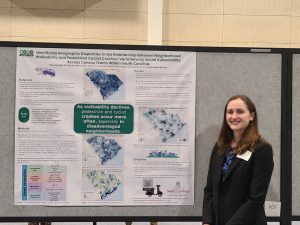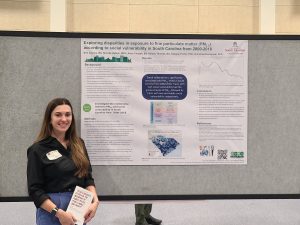On May 2nd, 2023, a couple of BEACH Lab members presented their research projects on health disparities at USC’s 14th Annual James E. Clyburn Health Equity Lecture. This lecture series was established in honor of Congressman James E. Clyburn for his partnership and ongoing contributions to reducing and eliminating health disparities. Read on to learn more below!

Anna Chupak, a first-year PhD student in the Department of Health Promotion, Education, and Behavior and a valued member of the BEACH lab, delved into a pressing health equity issue in her recent poster presentation. Titled “Identifying Geographic Disparities in the Relationship between Neighborhood Walkability and Pedestrian and Cyclist Crashes: Variations by Social Vulnerability Across Census Tracts Within South Carolina,” Anna’s study sheds light on the associations between neighborhood walkability and pedestrian and cyclist crashes while exploring variations in social vulnerability across census tracts in South Carolina. Anna meticulously compiled and analyzed data for all 1,103 census tracts in SC, examining neighborhood walkability scores from the Environmental Protection Agency (EPA), the total number of pedestrian and cyclist crashes from the SC Department of Transportation, and social vulnerability index scores from the US Census Bureau. Her findings reveal that pedestrian and cyclist crashes increase as neighborhood walkability declines, especially in more disadvantaged neighborhoods with higher social vulnerability. Her research has profound implications for identifying neighborhoods in dire need of infrastructure improvements to promote pedestrian and cyclist safety and to facilitate greater physical activity, thereby reducing the prevalence of chronic diseases like obesity.

Erin Looney, a first-year MPH student in the Department of Health Promotion, Education, and Behavior and member of the BEACH Lab, presented her work on “Exploring disparities in exposure to fine particulate matter (PM2.5) according to social vulnerability in South Carolina from 2000-2018.” Erin’s study investigated the relationship between PM2.5 and overall social vulnerability in South Carolina from 2000-2018. Erin categorized overall social vulnerability percentile rankings into tertiles (low, middle, and high) to analyze temporal trends and disparities in PM2.5 for low, middle, and high social vulnerability from 2000-2018, controlling for rurality. She found that social vulnerability is significantly associated with PM2.5 levels in South Carolina over time. Tracts with high social vulnerability had the greatest levels of PM2.5, followed by tracts with low and middle social vulnerability, respectively. The findings of her study highlight disparities in PM2.5 and the potential need for local policy, environmental, and educational interventions to mitigate air pollution exposure risk for socially vulnerable populations. Erin was honored to receive the New Investigator Award at the poster presentation session.

